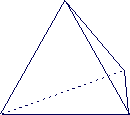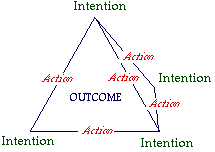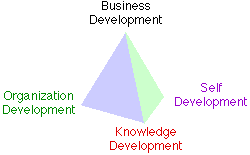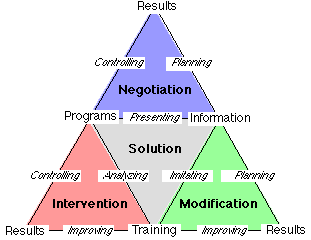








 Case Studies The Mastek Pyramid | Empowerment Pyradigm™ | Interview with a Cartis™ User | Use of Pyramids in Ford | Application of Pyramid Building in Organizations Application of Pyramid Building in Organizations:
Table of Contents What is It All About? We have developed a powerful multi-dimensional learning approach that works directly with client issues while allowing reflection, dialogue and agreement on three levels: Clarifying intentions, agreeing on desired outcomes and identifying actions that allow us to get to those outcomes. Thirty organizations including five Fortune 100 companies have used this methodology successfully in designing strategy, clarify their mission, design executive development programs in addition to designing books, management CD-ROMs and five year strategic plans with built-in assessment tools. It has four qualities that no other tool we have seen has: 1. It results in creating a
3-D model that fits in your hand and allows you to examine the model
from different perspectives and to understand it as a system. Introduction Most organizational change efforts have produced, mixed results. Models, approaches, and concepts that make sense in the beginning have often not produced desired outcomes. Somehow, the structures put in place, the strategy that drives the change effort, and the processes that bring about change leave people drained of energy. We would like to re-energize this process in a way that will engage people's vision and passion, and align change strategies with the processes that fulfill them.
Achieving Alignment Aligning an organization's strategy,
processes, and people is a challenge and almost unachievable in
most circumstances. When achieved, alignment greatly improves opportunities
for reaching desired outcomes. This challenge can be met where there
is integrity and a willingness to collectively face such questions
as:
The Pyramid Building Approach Our approach for aligning strategies,
processes and people explicitly allows organizations to clarify
intentions, take actions, and produce desirable outcomes. It is
particularly useful for revealing the relationships among critical
variables and for uncovering the implications for organizational
action and change. It provides a social context to discover values,
assumptions, and beliefs. Groups in thirty organizations in five
countries have used this approach to develop alignment for a wide
variety of purposes. Read an Interview with Tom Grant about Pyramid
Building in the Ford Motor Company. What is Pyramid Building? Pyramid Building is a method for identifying critical variables in a complex system and mapping their relationships and resulting interactions. The process relies on brainstorming, dialogue, and decision-making to build alignment among participants. The product of this process is a 3-D pyramid with identified intentions, actions, and outcomes mapped onto the corners, edges, and faces. The pyramid represents the clarity that has been achieved about the system's variables and their relationships. The meaning associated with each of these terms evolves and changes as we experience, learn, and dialogue. Nevertheless, at any given moment we are prepared to take action based on our understanding of these terms at that time. To be precise, we are creating
objects geometrically known as tetrahedrons, a pyramid with a triangular
base (see FIGURE 1 below).
Figure 1: A Tetrahedron
A tetrahedral pyramid has four
identical triangular faces, unlike an Egyptian pyramid which has
four triangular faces and a rectangular base. The Egyptian pyramid
is symmetrical only when rotated around a vertical axis. The tetrahedron,
by contrast, can be rotated around any axis and retain its shape.
Therefore, any corner can become the apex. Thus, there is no structural
hierarchy in the tetrahedron. Building the Enterprise Pyramid The CPR Group comprises three
partners. When we explored the potential of partnership, we knew
that we have complimentary skills and shared interests that would
support our working together synergisticly, but we needed to clarify
how we could align our these in a way that would include and transcend
our individual work and orientations. Our major professional efforts
had been organization development, researching the nature of learning,
and management consulting, each augmented by a shared interest in
self development. At the core of these disciplines, we identified
four importance processes:
Fig. 2: Our intentions formed the cornerstones of our Enterprise Pyramid This simple representation suggested
some lines of inquiry. Each cornerstone is connected to the other
three, so that each intention is forced into relation with the others.
For example, we began to ask ourselves: Our reflection and dialogue about the connections between pairs of intentions led to concepts that 'bridge' the two cornerstones. While the cornerstones represent our individual intentions, the edges represent the actions necessary to arrive at collective, shared outcomes. Our actions not only connect and balance our individual intentions but also 'include and transcend' the polarity between them. For example, we saw that strategizing
is where business development and knowledge development come together.
Knowledge is required to formulate a strategy for the business development.
The process of identifying strategies, in turn, focuses our efforts
in knowledge development. Strategizing does not have to include
organization or self-development directly and in many organizations
it doesn't! Self Development: visioning,
creating, realizing In this process of validating
intentions and actions, we reaffirmed our commitment to find outcomes
that supported our intentions. Fig. 3. Actions that include
and transcend our intentions We next examined the four faces of the pyramid. They took on the meaning of the outcomes produced by the actions of the adjacent edges and the intentions of the cornerstones. Each pyramid face represents an outcome 'field' produced by the interaction of three intentions and three actions. For example, 'Exploration' is the field that results from the actions of visioning, learning and creating; and the intentions of Organization Development, Knowledge Development, and Self Development (see Figure 4). Intention, Transformation, and Diffusion are the names of the other three fields. Each represents an outcome that is born out of a set of intentions and actions.
Fig. 4. The Enterprise Pyramid: intentions, actions and outcomes This tetrahedron represents the holistic development perspective that we share. Cornerstones represent our intentions, edges the actions that we could take, and the faces outcomes resulting from our interactions. Thus, using the pyramid as a model of our collective interests, we developed a shared view of the system that we comprise. We found ourselves aligned, not just around components of the system, but around a growing understanding of the dynamic relationships among them. The 'Other' Perspective Figure 4 nicely represented our intentions and the actions that can facilitate specific outcomes. This tetrahedron conveys a positive tone, because it represents our aspirations; it has an emergent quality to it. Why? Because we cannot predict what the result of transformation is going to be before it takes place. Thus, we called this 'The Emergent Perspective' But what was on the "other" side? We wanted to see how this perspective relates to our experience with the current reality of our clients' systems. We called this flip side 'The Foundation Perspective.' Let us examine what happens
in a business enterprise going through a change process. When people
are not in touch with their dreams and visions (shared or individual),
the context of change can feed resistance, anxiety and survival
behaviors. The organization becomes uninspiring and people lose
their energy and creative capabilities. But while people take change
efforts seriously and try to make them work, some also find ways
to avoid or even sabotage such efforts. While it is easy to let
go of such saboteurs, from their perspective, they may have a valid
reason to do what they do. Assuming that there is integrity in people's
resistance to change, we wanted to learn more about it. May be the
proposed change is too much a break from the past and may be the
organization is better served by focusing on continuous improvement
instead of transformational approach. Thus, our understanding of
the Enterprise would not be complete without examining 'The Foundation
Perspective' as well, and our ability to produce short-term results.
So we set about designing a complementary 'Foundation Perspective'
(see Figure 5). Fig. 5. The Foundation Perspective of Enterprises Why Examine the 'Other' Side? When an organization is running
smoothly and not undergoing rapid change, leaders focus on: Results,
Programs, Information, and Training. They reflect a pragmatic attitude
that is intended to sustain and grow the current organization. This
approach focuses on what works and avoids looking at why it does.
Results at the Foundation level
are pragmatic, e.g., continuous improvement is intended to solve
a problem or meet an immediate need, and is not involved in a revisioning
of the organization. Thus, a way of thinking about the difference
between results in the Emergent and Foundation Perspectives would
be to think of an athlete's performance. When an athlete conditions
and practices, her focus is on long term gains, developing her skills
and stamina over time. While there may be one major goal, an Olympic
Medal or a championship, there are many challenges along the way.
The conditioning and practice program is geared to meeting each
of these challenges with increasingly effective performance. We could also see the actions
that routinely take place in the organization: planning, controlling,
improving, analyzing, presenting, and imitating (we generously call
it benchmarking). These are all actions that support smooth functioning
of an organization and support the pragmatic approach. This Foundation Perspective
helped us to see what creates stable organizations that focus on
continuous improvement. They have clear ground rules and a nurturing
(albeit somewhat controlling and more mechanical) culture. Expectations
and/or performance criteria are known. There is consistency for
routine activities. This is the Foundation on which emergent perspectives
can develop! Figure 6: Emergent and Foundation cycles Emergent and Foundation Perspectives It is possible to look at both perspectives as polarities. When taken to an extreme, The Emergent perspective reveals self-organizational characteristics including uncertainty, creativity, generativity, and new possibilities. Similarly, when the pressure is on, the Foundation perspective could reveal mechanistic, control-focused routines, rules and regulations that only support changes around expediency and refinement. When we look at these two perspectives as contrasting and complimentary as the two sides of the same coin, the whole Enterprise Pyramid models an environment of both chaos and immediacy. In an organization that embraces both perspectives, change is self-generated and transformational, both practical and aspiring. Exploring both perspectives and their relationships creates a developmental approach to organization building and alignment (see Figure 7). In such organizations, it is possible to look at long term strategy and be flexible and dynamic while taking short term actions.
Emergent and Foundation Perspectives
An emergent approach (with intentions of business, knowledge, organization and self development) allows for clarity of vision and values, vision based strategy, creativity, and learning leading to the realization of enterprise goals. A foundation approach (with intentions of results, information, programs and training) allows for workable plans, good market analysis, meaningful presentations, good control structures and focus on continuous improvement. Emergent approaches which ignore requirements for short term gains, structures and systems and only pay attention to creativity, fluidity, flexibility and individual responsibility can self-destruct. One company, Virtual Reality Systems, was started with very little seed capital. In order to secure more, the owner put his patents up as security. Lenders foreclosed and took the patents. The owner lost out. More effective attention to the foundation might have saved his position. If there is inadequate attention to the tactical and short term, leaders can lose support from key stakeholders or simply lose track of the bottom line. When people stop creating and the market is no longer enthusiastic about its products and services, an emergent organization without suitable control mechanisms in place becomes unable to deal with new market realities and disappears. Our innovations need the support of our structures. Our structures need to support our innovations. On the other hand, the foundation approach based organization has difficulty adopting to rapid changes in the marketplace. For example, Diablo printer company was one of the premiere companies supplying daisy-wheel printers connected to personal computers in the 1980s. They had excellent quality products, world class manufacturing facilities and the support of Xerox behind them. Markets moved on and the laser printers and (later) ink jet printers took over the market leadership and all their quality did not save them from extinction. From this brief analysis we learned that each perspective has to respect and support the other. Without the support of the one, the other collapses. When both perspectives are supported in an organization, it could truly become a learning organization even though we are still to find one such company in reality. We were quite pleased that our pyramid building led not only to a organization design framework but also created shared strategy, processes and, most importantly, shared meaning with deeper alignment among the three of us. How Has the Pyramid Building Approach Influenced Our Own Work? The Emergent Perspective is very useful in identifying where resistance and potential lie for future development. We have learned to include and transcend self development as an integral part of business, knowledge and organization development activities. The Enterprise Pyramid helped us focus our attention on critical issues. We ask ourselves in engaging with each other and with our clients, questions about our intentions (Why are we engaged in this process?), the topics for exploration (Is it necessary to follow this path or should we approach the problem differently?), the possibilities for transformation (Does this process include all the parties and transcend their goals and objectives or is it a stop-gap process to reduce damage while we find an alternative?) and the means for diffusion (Did we include suitable communication processes and structures to let our clients learn and use what they learned with us themselves?). We have used the Enterprise Pyramid to help us clarify our relationships and roles with clients, as well as to explore client-centered activity. Building this pyramid has helped our collective enterprise development strategy by including and transcending our individual approaches in addition to clarifying our individual strengths and interdependencies. It has helped us clarify our aspirations and attend to the immediate needs of our association. Application of This Approach in Other Organizations In over four years of using this approach in a wide variety of contexts and for a wide variety of purposes, our clients have found it to be a stimulus in confronting complexity and integrating diverse perspectives. In building over fifty pyramids in organizations, we could see that this approach has much broader application than we originally intended. We found the Pyramid Building Approach to be useful in developing shared meaning and alignment. It is also valuable in helping clients to o think systemically, Conclusions The pyramid building approach provides a fresh way for thinking about complex systems and for dynamically aligning people, processes, and strategy for purposeful action. We found that this approach is very useful in developing agreement and alignment in not only a three-person team like ours, but also in the complex, ambiguous, polarized, and high-tension environments found in large organizations. At the root of this utility is the approaches' potency in supporting individuals and teams in clarifying their intentions, the actions necessary for carrying out these intentions, and the outcomes they wish to achieve. Clients have reported major benefits in using Pyramid Building. They have structured their work more effectively, developed strategies, organized action in a complex context that has become more understandable to them. Whatever their purpose for using the Pyramid Building Approach, the end result included clarity of intention, strategy for action, and alignment in teams. Learning and discovery become more lucid. Most importantly, the members of their teams, organizations, and stakeholders have become more aligned in their work together. Organizations need to continue to develop models and methods that enable them to understand dynamic relationships among complex sets of variables. Change efforts risk being cosmetic or inadequate unless organizations are able to account for the complex web of influences among strategies, processes, and people. The Pyramid Building Approach (both as a systems model and holistic method) supports heightened awareness, increased clarity of perspective, and alignment among organization members in the face of complexity.
E-Mail: Prasad Kaipa, pkaipa@selfcorp.com, Chris Newham, crnewham@aol.com, or Russ Volckmann russv@ix.netcom.com You can send any comments or suggestions by clicking here: comments@selfcorp.com |






